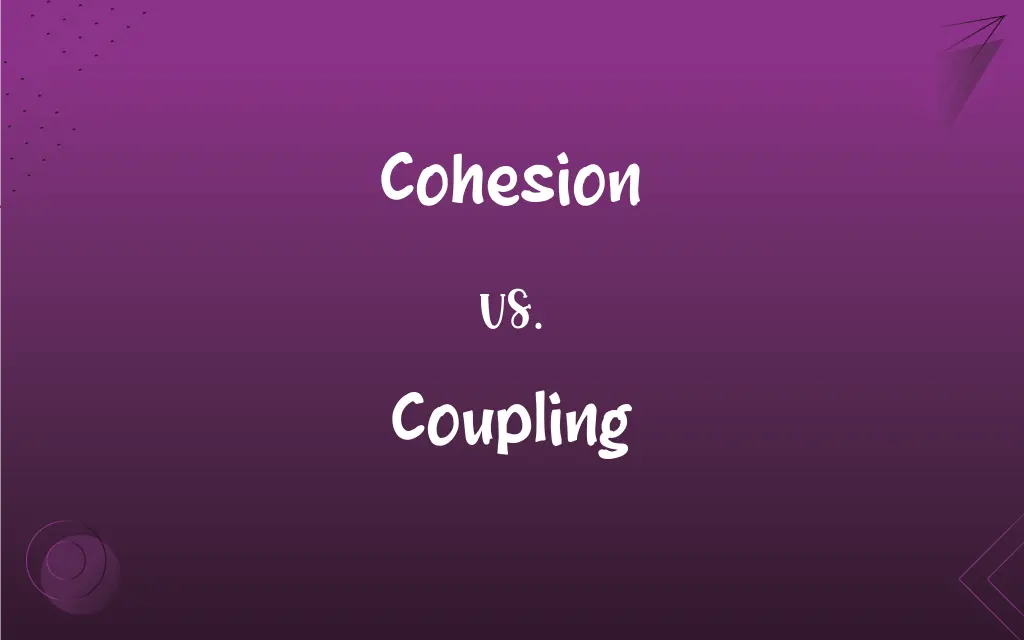Cohesion vs. Coupling: What's the Difference?
Edited by Aimie Carlson || By Janet White || Published on February 5, 2024
Cohesion refers to the degree to which elements within a module belong together, while coupling describes the level of interdependence between modules.

Key Differences
Cohesion in software engineering is about how closely related and focused the responsibilities of a software module are. High cohesion means that the module's elements are closely related to each other, enhancing maintainability and understanding. On the other hand, coupling refers to the degree of interdependence between different modules. Low coupling is desirable as it means changes in one module have minimal impact on others, promoting modularity and ease of change.
Cohesion is an internal attribute of a module, focusing on its own elements and functions. A highly cohesive module performs a specific task or a closely related set of tasks, reducing complexity and improving clarity. In contrast, coupling concerns the interactions between different modules. High coupling indicates that a module heavily relies on or affects other modules, which can lead to complex dependencies and make the system harder to maintain.
Achieving high cohesion within a module means that it has a single, well-defined purpose. This makes the module easier to understand, test, and maintain. Coupling, conversely, should be minimized in a well-designed system; less coupling between modules means that each can operate more independently, reducing the ripple effect of changes and simplifying integration.
Cohesion enhances the functionality within a module by ensuring all its elements are essential to its purpose and functionality. This focus on relevance and necessity within a module contrasts with the concept of coupling, which ideally should be minimized to promote loose interconnections between modules, allowing for easier modification and extension of the system.
High cohesion is often associated with increased reusability, as tightly focused modules can be easily adapted or reused in different parts of a system. In terms of coupling, lower levels are indicative of a system where modules can be changed or replaced with minimal impact on others, facilitating easier updates and scalability.
ADVERTISEMENT
Comparison Chart
Focus
Internal structure of a module
Interdependencies between modules
Desired Level
High (tightly focused functionality)
Low (minimal dependencies)
Impact on Maintainability
Enhances (simplifies understanding and changes)
Reduces (complicates changes and understanding)
Relationship to Functionality
Specific, well-defined purpose
Inter-module interactions and effects
Effect on System Design
Promotes reusability and clarity
Should be minimized for modularity
ADVERTISEMENT
Cohesion and Coupling Definitions
Cohesion
Cohesion in software indicates tightly focused and interrelated functionality.
Due to its cohesion, the payment processing module operates efficiently.
Coupling
Coupling is a measure of how changes in one module affect others.
Their tightly coupled architecture made bug fixes a complex task.
Cohesion
Cohesion is the measure of how closely related the functionalities within a module are.
The module's high cohesion made it straightforward to maintain.
Coupling
In software, reducing coupling facilitates easier maintenance and scalability.
By decreasing the coupling, the software became more adaptable to changes.
Cohesion
High cohesion within a module simplifies understanding and enhances maintainability.
The cohesive structure of the codebase facilitated easier updates.
Coupling
Low coupling in software design means minimal reliance between different modules.
The system's low coupling allowed for easy integration of a new feature.
Cohesion
Cohesion refers to the singularity of purpose within a software module.
The cohesive design of the logging module made it reusable across different applications.
Coupling
Coupling describes the level of dependency between different software modules.
We aim to reduce coupling to make our modules more independent.
Cohesion
Cohesion is about ensuring that all elements of a module contribute to a single task.
The team improved the cohesion of the user authentication module for better performance.
Coupling
Coupling assesses the degree of interaction and interconnection between modules.
The project's success was partly due to its low coupling between core components.
Cohesion
The act, process, or condition of cohering
Exhibited strong cohesion in the family unit.
Coupling
The act of linking together or forming couples.
FAQs
How can cohesion be improved in a software module?
Cohesion can be improved by ensuring all elements of the module contribute to a single, well-defined task.
Why is high cohesion important?
High cohesion ensures a module is focused, understandable, and easier to maintain.
What are the drawbacks of high coupling?
High coupling can lead to complex dependencies, making a system harder to maintain and modify.
What is cohesion in software development?
Cohesion refers to how closely related and focused the tasks within a software module are.
What is an example of low coupling?
Low coupling is evident when a database module can be replaced without affecting other modules.
What is an example of high cohesion?
An example is a logging module solely dedicated to logging activities in an application.
What does coupling mean in software engineering?
Coupling is the degree of interdependence between different software modules.
Can coupling affect system scalability?
Yes, lower coupling levels generally allow for easier system scalability and integration.
Is it possible to have zero coupling?
While zero coupling is ideal, some level of coupling is often necessary for module interaction.
How does coupling impact software integration?
Lower coupling levels facilitate easier integration of new modules or features.
Does cohesion relate to the size of a software module?
Cohesion is more about the focus and relatedness of tasks within a module than its size.
Is low coupling desirable in software design?
Yes, low coupling is desirable as it indicates minimal dependencies between modules.
How does cohesion affect software testing?
High cohesion usually makes modules easier to test as they have a clear, singular purpose.
Can high coupling lead to challenges in code refactoring?
Yes, high coupling can make refactoring challenging due to complex inter-module dependencies.
What's the relationship between cohesion and software complexity?
Higher cohesion typically reduces software complexity by focusing on singular tasks within modules.
Can high coupling affect software performance?
Yes, high coupling can impact performance due to the overhead of managing complex dependencies.
Are cohesion and coupling only relevant in object-oriented programming?
While often discussed in object-oriented contexts, cohesion and coupling are relevant in various programming paradigms.
What strategies can reduce coupling in a software system?
Strategies include using interfaces, design patterns, and separating concerns to reduce dependencies.
How does high cohesion benefit software maintenance?
High cohesion simplifies updates and maintenance due to the module's clear and focused purpose.
What role does cohesion play in software reusability?
High cohesion often leads to increased reusability of modules in different parts of a system.
About Author
Written by
Janet WhiteJanet White has been an esteemed writer and blogger for Difference Wiki. Holding a Master's degree in Science and Medical Journalism from the prestigious Boston University, she has consistently demonstrated her expertise and passion for her field. When she's not immersed in her work, Janet relishes her time exercising, delving into a good book, and cherishing moments with friends and family.
Edited by
Aimie CarlsonAimie Carlson, holding a master's degree in English literature, is a fervent English language enthusiast. She lends her writing talents to Difference Wiki, a prominent website that specializes in comparisons, offering readers insightful analyses that both captivate and inform.






































































